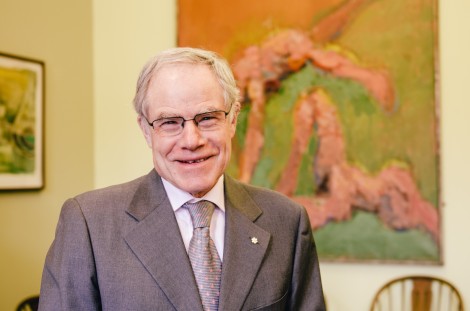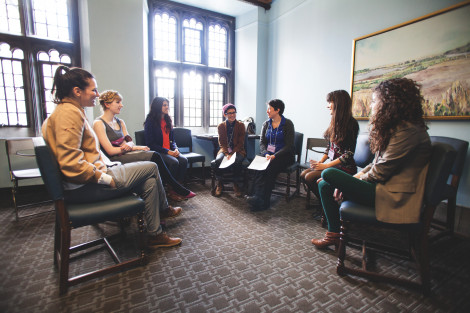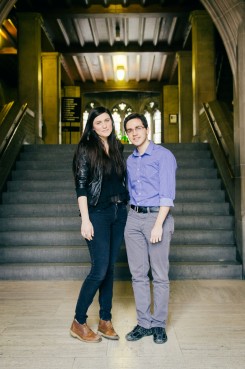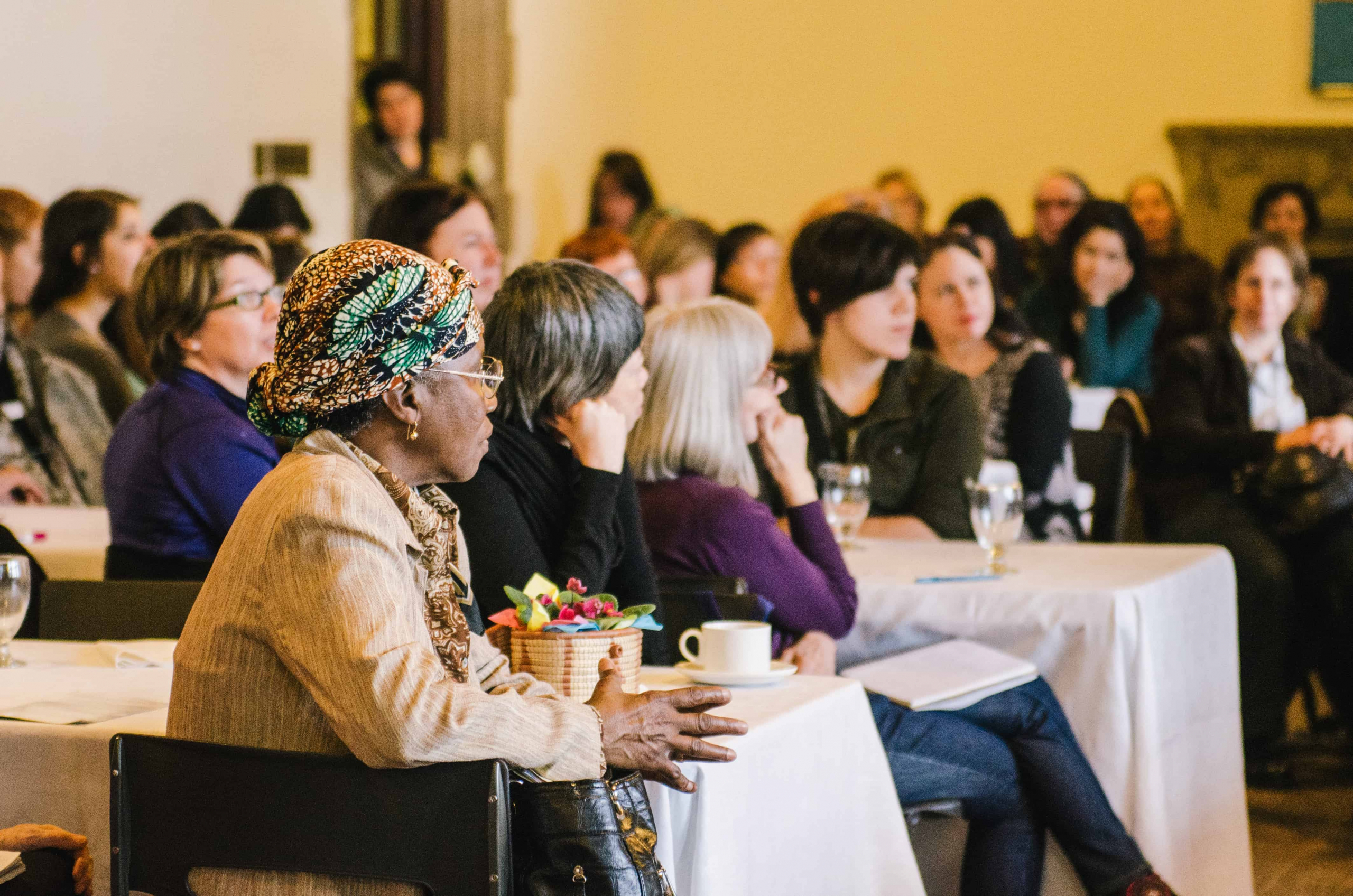Since its establishment in 1919 with funds from Toronto’s wealthy Massey family, Hart House has served as a uniting centre for the University of Toronto. It is a source of pride, an architectural focal point, and an intersection for students’ artistic, academic, and athletic pursuits.
“Dry Creek” from Alpine Sequences by OK Ikumi — helaudio.bandcamp.com/album/alpine-sequences
As Northfrop Frye wrote in 1969, “Hart House represented the university as a society; it dramatized the kind of life that the university encourages one to live: a life in which imagination and intelligence have a central and continuous function.”
But it was not until 1972 that women were first allowed to be full members, meaning this romanticized society wholly excluded them.
The change was partially made possible by the passing of one-time Governor General Vincent Massey in 1968. Massey, who in his lifetime still exerted some control over Hart House’s direction, once remarked, “It’s a pleasure to be in a country where women cannot mix everywhere.”
On March 8, International Women’s Day, Hart House, in collaboration with the University of Toronto Multi-Faith Centre, played host to the Breaking New Ground conference in recognition of the 40th anniversary of the extension of full membership rights to women at Hart House. Panelists began by discussing the difficult history of Hart House, reflecting on its exclusivity, and on injustice towards women in the university at large.

Hart House warden Bruce Kidd BERNARDA GOSPIC/THE VARSITY
“Not about the letting in, but the getting in”
Although today Hart House is a remarkably inclusive space and is mandated to continually bolster its accessibility, it was once a site of bitter oppression for women.
Until 1972, women were granted limited access to the building, and were denied any form of casual entry into the facility. They were allowed in for special events such as dances, or during certain hours accompanied by a man.
Panelist Michele Landsberg, an award-winning author and journalist, described her experience of being banned from Hart House, having begun studying at U of T in 1958, already an eager feminist.
“I was shocked to realize that I was barred from the facility. I lived in the suburbs and had a long hike down to the university. Whenever I wanted to stay for the evening, there was nowhere on campus for me to wait. There was only the library.
“At Hart House, the windows were glowing and the men inside were gathered around the fireplace and women were absolutely not allowed. It was enraging, it was insulting. I was disgusted. It was exactly the same to me as segregation… It was obvious to people that women were second-class.”
Landsberg recalls an “insulting, degrading notice” on the door of the Arbor Room, stating that ladies could be admitted after 3 pm, only if “in the company of a gentleman,” which prompted her to complain to the Dean of Women.
“It was sickening and so condescending… I went to complain very bitterly about this Hart House situation. She looked at me as though I were mentally deranged. She said: “we’re going to build a women’s athletics building in the near future. I said, ‘I don’t care. There should not be a facility on the campus that bars women.’ She couldn’t understand that.”
Although the Massey Foundation set aside $125,000 in 1919 to fund a female recreational building to open alongside Hart House, the plan never materialized due to constant roadblocks, including concerns over the ‘indecency’ of women exercising outdoors. After decades of controversy, the Benson Building was constructed in 1959 at Harbord and Huron Streets, but it was a poor compromise, serving solely as an athletic building, rather than as a multipurpose space. In A Path Not Strewn with Roses, a history of women at the University of Toronto, author Anne Rochon Ford writes: “The forty-year struggle on the part of women students and faculty to get that building is one of the saddest untold stories of women’s history at the University of Toronto.”
Landsberg admits that she continues to harbour bitter feelings towards the building and the university in general. “The sexism of the campus at that time affected me in every way. I was prevented from going on to graduate school although I did score very high… It was that kind of sexism that barred so many women from so many paths.”
Although Landsberg felt isolated and without a feminist community to support her at U of T courageous women had been pushing for female inclusion at Hart House prior to her arrival at the university. Before the opening of the building, women were already attempting to garner support for a similar facility for women. Ford notes that as early as 1911 a motion was passed to distribute a petition to the colleges, which stipulated the inclusion of a women’s gymnasium in the plans for Hart House. Although this effort was unsuccessful, discourse about the need for a women’s athletic space had begun.
The October 17, 1919 issue of The Varsity, published the same year the doors of Hart House first opened, included an article titled “A Co-Educational Social Centre.” The piece highlighted the need for female inclusion at Hart House, stating, “It is with longing eyes that the women of the University gaze on the towering grandeur of Hart House, and sigh in vain for an ‘Open Sesame’ to those sacred portals which guard their fabulous treasures from the feminine view.”
Current Hart House warden Bruce Kidd, a noteworthy champion of equity, remarks, “The activism of women against the male-only character of Hart House has a long history. There were stories from the ’20s and ’30s of women who broke in… There was certainly a lot of activism in the ’50s. The Varsity was a leading proponent of the admission of women to Hart House. One of the outstanding editors of The Varsity in the 1950s, Wendy Michener, wrote a number of brilliant editorials arguing for the inclusion of women.”
Breaking New Ground panelist Dr. Meg Luxton, professor and director of the graduate program of Gender, Feminist and Women’s Studies at York University, participated in these efforts, which she described at the conference as “a fairly noisy, disruptive political movement.”
Luxton recalls standing up with her female classmates in unison and yelling out questions when a professor wouldn’t take questions from women, and occupying two buildings in different protests. “We learned to work together.”
The feminist movement at U of T produced some famous legends of female resistance. One such anecdote is relayed to me by several different people in slightly inconsistent versions. A debate on US foreign policy between John F. Kennedy and Stephen Lewis was held at Hart House in 1957. The story goes that in the rain outside the debate, women held a demonstration. Some attempted to sneak in, but were allegedly caught when one woman’s manicured hand was noticed by a security guard. Kidd describes this incident as a “watershed.”
Another story is that of Olympic track and field athlete Abby Hoffman. In the 1960s, Hoffman was training as a runner, and snuck into the indoor track at Hart House to escape practicing in the bitter winters, disguising herself as a man by wearing a hood. Her teammates, including Kidd, helped her in through the back door. In 1966, fed up with these circumstances, she presented herself three times to train, and each time she was “unceremoniously thrown out into the snow.” Kidd explains that Hoffman’s case became a “cause-celebre” and was an important pressure point for allowing women into Hart House.
Opposition to the inclusion of women at Hart House came from the Massey family, as well as from the administration, faculty, and some U of T students. Many, however, were progressive, and a diversity of opinions existed. “It was a complex landscape,” Kidd notes, “It wasn’t polarized in terms of advocates and opponents.”
Event organizer and head of the Hart House Social Justice Committee Carly Stasko points out during the opening remarks at the Breaking New Ground conference that “it’s not about the letting in, but the getting in,” emphasizing that co-ed access to the building was not simply granted from above, but obtained by the impressive efforts of a unified group of women.

Participants at the Making Inclusion Happen workshop YI ZHAO/THE VARSITY
“Only a matter of time”
Kidd notes that, in retrospect, inclusion of women at Hart House was “only a matter of time” by 1970.
“By 1970, women had made the issue of admission one of the highest priorities of activism on campus… Women were pounding on the door in all kinds of ways — sitting in on debates; [female] Varsity reporters were showing up at special lectures. There were more and more men who were encouraging women to sneak in.”
By then, the Benson Building was available to female athletes, but many women continued to bemoan the inadequacy of this solution, asserting that their inability to enter Hart House was sexist and unfair. In 1971, an Advisory Committee was established to consider the access of women to Hart House. After a change of deed was successfully sought from the Massey family, the Board of Stewards voted in favour of female admittance in January of 1972. By July that year, women were granted full membership to Hart House.
“It’s a bittersweet victory,” Landsberg reflects. “A lot of harm was done over the years… When I finally started attending events at Hart House, I entered with a mixture of loathing and unsatisfied indignation. I still feel that way. There’s certain harms that you don’t get over.”
Panelist Dr. Keren Brathwaite, co-founder of the Transitional Year Program, echoes Landsberg’s sentiments at the conference. “I want to remember how disenfranchised we were. I want to remember the struggle that brought us to this day.”
Kidd remembers his male colleagues complaining that they had to swim in bathing suits following the change-over, rather than the previous custom of using the pool naked. He also notes that it was very difficult for women to use the pool and gym facilities, as there were initially no provisions for female locker rooms to be built. It was only in the early 1990s that the large men’s dressing room was divided into two equal change rooms.
Panelist Dr. Kathryn Morgan, a U of T philosophy professor, adds, in correspondence with The Varsity, “There was a lot of bullying of women when Hart House was sex-integrated, particularly in the swimming pool… Some of it was verbal, some of it was leering.”
Misogyny didn’t cease to exist at Hart House in 1972, nor did the efforts of feminists come to a halt. It took time for the institution to adapt to the change.
Expanding Accessibility

Evelyn Smith-Romero and Abtin Parnia of the Hart House Social Justice Committee. BERNARDA GOSPIC/THE VARSITY
In contrast to this dark history, Hart House possesses a counter-history of progressiveness, moving away from its Christian foundations to embrace different religions, increasing wheelchair accessibility, and serving as a lgbt-friendly environment. Major efforts are currently being made to ensure the inclusivity of the facility to women and all minorities. Although one facet of the Breaking New Ground conference was reflecting on the hurdles faced by women, the major emphasis was on the current moment in feminism and moving forward to further expand accessibility at Hart House.
In terms of ongoing barriers to accessibility, Kidd cites having only one accessibility entrance for people with disabilities.
The building is an historic site, rendering physical alterations difficult, so efforts to increase inclusivity have focused on publicity and events. Kidd invites any student who feels unwelcome to visit his office and let him know why they feel that way in order to mitigate their concerns. “We want every U of T student to feel welcome here, that this is your house,” he says.
In addition to a panel and a keynote speech by highly active feminist Judy Rebick, the Breaking New Ground conference included workshops about gender, sexuality, racism, and well-being. The goals of the workshops, Stasko explains, were both to celebrate women and reclaim the space of Hart House, as well as to discuss the legacy of the facility.
“The initial idea came out of saying, ‘so it’s been forty years since women were welcome to Hart House — who’s not welcome now? What kind of exclusion is normalized still?’”
The Hart House Social Justice Committee facilitated one such workshop, titled Making Inclusion Happen, addressing precisely these questions.
Speaking to The Varsity, Evelyn Smith-Romero, Committee Co-Secretary, points to the question of men’s right groups as a potential challenge to inclusion.
Communications executive Abtin Parnia comments, “Any sort of stigmatized groups, they all fall under the same umbrella of inclusivity, because you have to consider all these groups when you want to organize an event… We want to look critically at the whole process of inclusion, how it happened, and whether there are still barriers for any groups to get engaged in Hart House.”
Participants in the workshop and the conference were encouraged to voice or write down their concerns over inclusivity, which will later be compiled in a report with a view towards implementing change and continuing the momentum of increasing accessibility.
At the conference, in a room filled with influential women, it was clear that Hart House has seen massive changes since its opening. In the 40 years in which women have been members at the facility, it has evolved into a decidedly inclusive, space, which ardently strives to give even more students access.
Kidd encourages students to explore the building and recognize their hard-earned ownership of it. “Come in to Hart House and treat yourself to an hour of discovery… Just spend an hour wandering around this place, so that you’ve got time to discover and reflect. Just spend an hour thinking, ‘this all belongs to me and all these opportunities are available to me.’”
In my explorations of Hart House, I’ve discovered rooms surrounded by portraits of men, the stone monkeys overlooking the main entrance, the matchstick strikers on the walls. Despite the trappings of the building’s male-oriented past, women are visible at the gym, on committees, running events; the voices of women past and present resonate in the halls, claiming the building as their own. In his office, the warden eagerly shows off a plaque featuring an image of Hoffmann that commemorates 40 years of women in Hart House, and recalls a quote by Robin Morgan: “Only she who attempts the absurd will achieve the impossible.”


